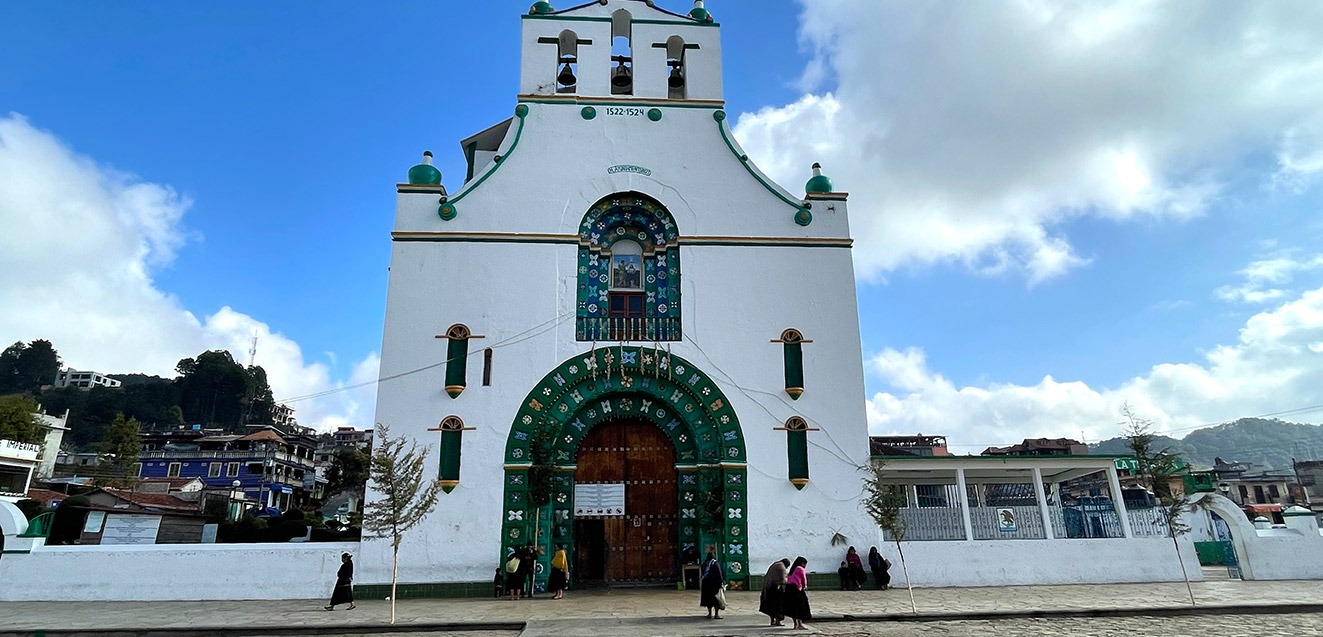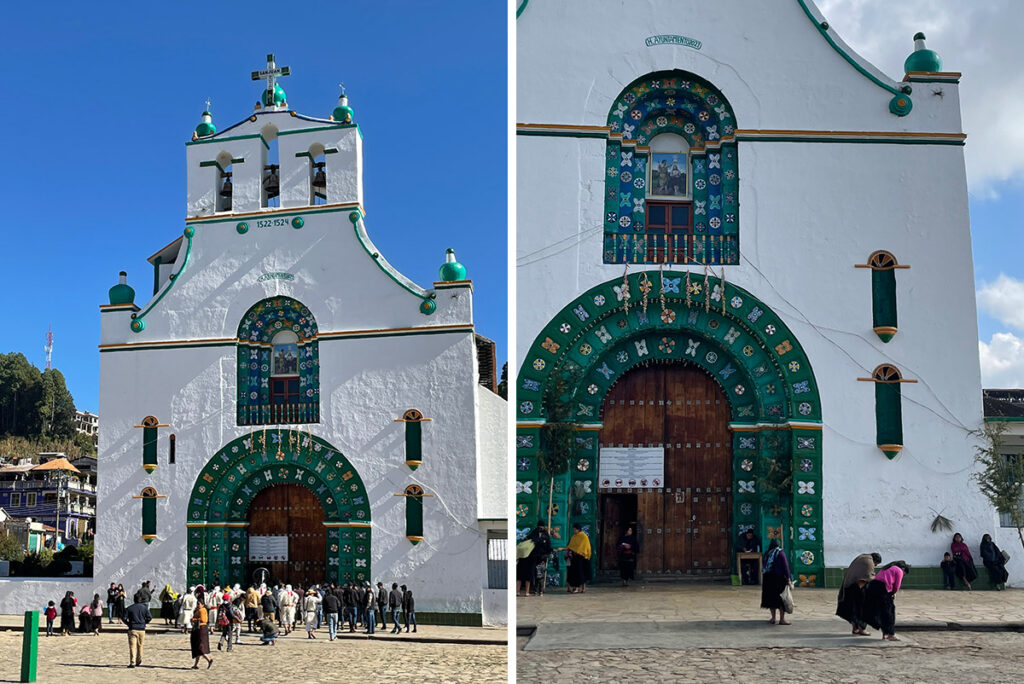Magical Moments in Mexico: The Enchantments of Chamula

If we are very lucky, our travels sometimes bestow moments of awe, when the everyday thread of our journey unexpectedly interweaves with a deeper thread of universal truth and connection. While traveling to Mexico in January, I was lucky enough to experience one of these magical moments.
The setting was San Juan Chamula, a compact township in the mountains of the southern Mexican state of Chiapas, about 100 miles from the Guatemalan border. Indigenous Maya people compose the vast majority of the population in Chamula, and as in a number of villages throughout Chiapas, these people have found a way to merge ancient practices and beliefs with more modern symbols and settings. This was poignantly evident on our visit to the local cathedral, which is set on the main square, right in the heart of the town.

As my group walked across the broad plaza towards the centuries-old church, which was brilliantly whitewashed and had brightly painted and decorated green arches, we passed a towering green cross set in a pedestal. At first sight, this seemed like a vivid Christian cross, but then we noticed that fresh green tree branches had been tied to it. Our guide explained that this symbol actually predates the arrival of Christianity in the region: It represents the Maya Tree of Life, its roots reaching down to compose the underworld, its canopy forming the heavens, and its trunk symbolizing our everyday earthly home. This Maya-Christian mingling is called syncretism, and it has a special power in Chamula, as I was about to discover.
Continuing our approach, we saw two indigenous women who had been walking towards the entrance suddenly stop in front of the church, then turn to the east. They stared straight ahead for a few seconds, then, at the same time, both bowed low. “They’re honoring the sun before entering the church,” our guide explained.
When we stepped into the cathedral itself, another world came to life: Within the musky, age-old hush of a sacred place, sweet copal incense swirled, mottled, smoky light streamed from stained glass windows, and hundreds of candles shimmered. Statues of saints in wooden, glass-faced cabinets lined the sides of the church, and a statue of St John the Baptist was mounted at the far end of the sanctuary, but the rest of the scene was unlike any church I had ever entered before.
There were no pews or chairs of any kind; instead, the smooth, tiled floor was covered with a layer of slippery and aromatic pine needles. Here and there around the cavernous interior, pockets of families had cleared away the pine needles and were kneeling in small groups—some quietly singing, some chanting—on the floor. And candles flickered everywhere, in front of the statues of the saints, on tables set along the sides of the church, and in meticulous rows on the floor, placed and lit by the kneeling faithful.
Of the half-dozen groups, one in particular caught my eye. This was a three-generational family of three accompanied by a wizened, gray-haired woman whom our guide said was a healer. The healer and the grandmother were dressed in the traditional indigenous clothing of Chamula, shaggy black woolen skirts and somber shawls. The granddaughter, perhaps five years old, was dressed in a dark skirt and bright pink shawl. The middle-generation woman—mother of the child, child of the grandmother—was dressed in a shiny, formal Western-style blouse and skirt.
As the healer spoke softly, the mother carefully placed and lit multi-colored candles one by one on the floor, forming multiple rows. Our guide explained that they were probably praying for the health of the daughter. After she had placed all the candles, the mother took a plastic bottle filled with a clear liquid called pox, a distilled mixture of corn mash and sugarcane, and lightly sprinkled it among the candles. Then she took a bottle of Coca-Cola and did the same.
All the while the grandmother was chanting a prayer in her Tzotzil language. As I watched and listened, I noticed something move to the left of the kneeling healer. Looking more closely, I saw that it was a chicken in a bag! Our guide explained that at one point in the ritual, the chicken would be sacrificed—its neck wrung—as an offering to the saints.
Just after he said this, the healer took the chicken from its bag and holding it tightly, passed it over the head, arms, and back of the girl, three times. The girl kept her eyes tightly closed as the healer bowed and said some words, then held the chicken on her right side and with a practiced, subtle twist of her hands, completed the sacrifice. As the chicken lay inert, she sang a soft chant.
The girl opened her eyes, the mother poured a glass of pox, and all the family members drank from the glass. Then she poured a glass of Coca-Cola, and they all drank from it. As they passed that glass, our guide explained that the carbonated drink is important to the rite because burping signals that evil spirits are being expelled from the body.
The rest of my group moved on, but with my own daughter and new granddaughter in my mind, I stayed and watched this family for a long time: the little girl alternately stretching restlessly and staring enchanted at the candles, the mother and grandmother earnestly praying, the healer speaking in a low voice to them both.
I looked at the saints arranged in their cases on the sides of the church, and at St John the Baptist presiding over all at the far end. Then I looked at all the groups kneeling on the smooth, pine-needled floor, each with their rows of candles and their bottles of pox and Coca-Cola, their chickens held in a box or a bag. At some point I stopped trying to understand and just opened myself to the scene: the pine needles prickly and pungent beneath me, the copal incense swirling around me, the flames a flickering ocean of light, the murmuring voices mesmerizing.
A ceaseless procession of believers moved through my mind, century after century, generation after generation, day after day after day, kneeling on the cool tiles, lighting their candles, offering their sacrifices, pouring their prayers into the air. I closed my eyes and heard the chants of Buddhists in Shikoku intoning the Heart Sutra, parishioners in Notre-Dame saying the Lord’s Prayer.
An ageless yearning spun within me and outside me, and a filament rose from my soul into the fervent, flickering air.
I lost a thread of myself to the shawl of Chamula, and found a greater weaving there.
* * * * *
What moments of awe have you experienced on your travels? We’d love to hear from you! Please share your experience in the comments section below. Thank you!
* * * * *
Don George leads GeoEx’s small group journey, Mexico: Maya Traditions in Chiapas. To learn more or to reserve your space, call our travel experts at 888-570-7108.
David K.
Don my wife and I were with you on this incredible trip. Thank you for leading us on this adventure of culture!
Take Care my friend.
Beautifully written; brings tears to my eyes. Thanks Don
Beautifully written, Don. Thank you for sharing those thoughts and experiences. Like you, I have been fortunate enough to have had those mystical, magical moments that some might call “a religious experience”. Sometimes they’ve been in a church, or temple or monastery or synagogue or mosque or just walking along in the forest or on a mountain trail. Those are the very special moments in life that are the reason we travel near and far. Thanks again.

